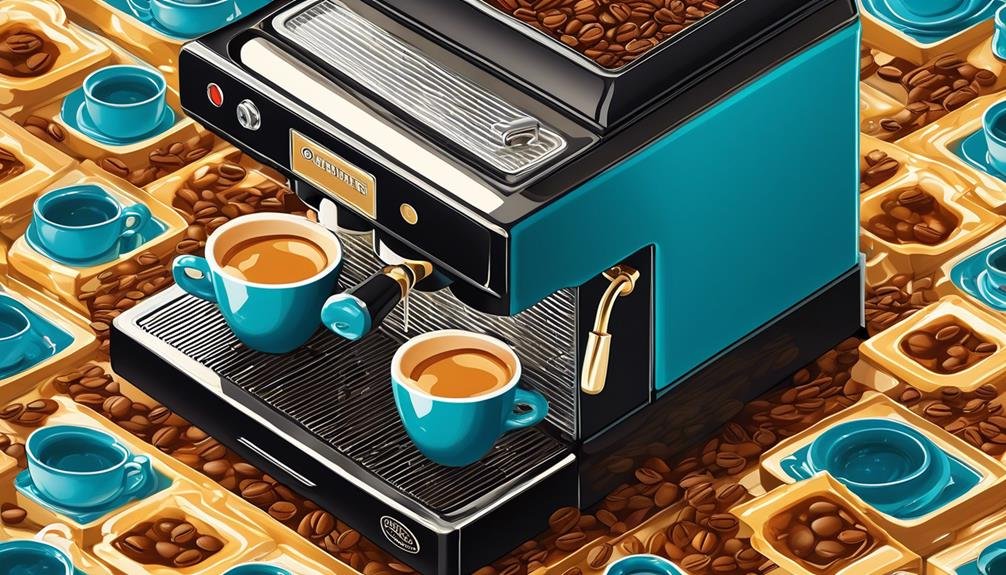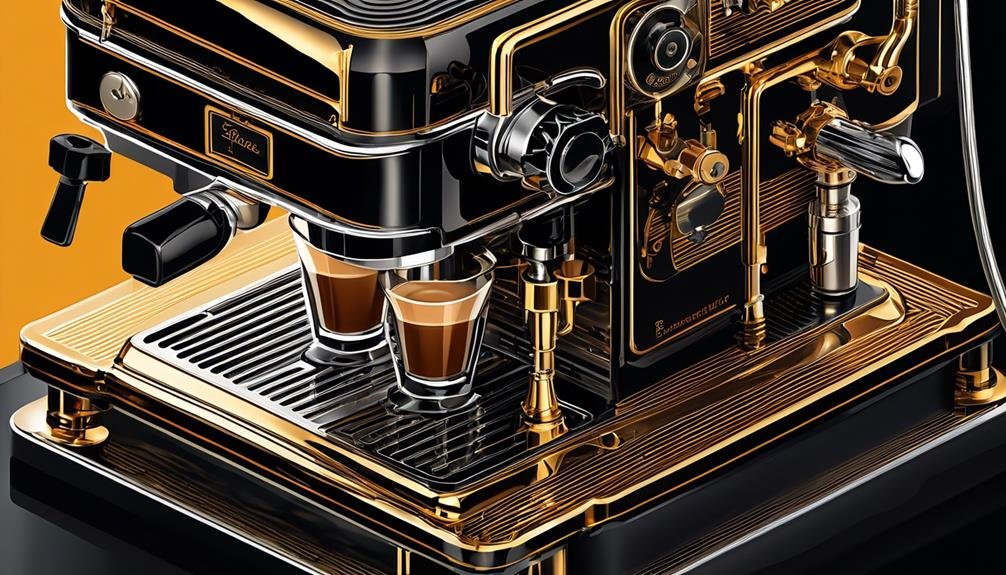Have you ever wondered why espresso machines require such high pressure to brew a perfect shot of espresso? Well, let's take a moment to consider this intriguing question.
Picture yourself in a bustling café, eagerly waiting for your morning pick-me-up. As the barista expertly operates the espresso machine, you notice the distinct sound of steam being forced through the coffee grounds. But why is this high pressure so crucial?
What role does it play in creating that rich, flavorful cup of espresso that you crave? Stay with me as we unravel the science behind the need for high pressure in the world of espresso brewing.
Key Takeaways
- High pressure, typically around nine bars, is necessary for extracting the oils, flavors, and aromas from coffee grounds.
- Insufficient pressure results in weak and under-extracted shots, while excessive pressure leads to over-extraction and a bitter taste.
- Tamping the coffee grounds enhances resistance and ensures even extraction.
- Different pressure levels yield varied taste profiles, with higher pressure resulting in bold and intense flavors, and lower pressure bringing out fruited and distinct flavors.
The Science Behind Espresso Pressure
Understanding the science behind espresso pressure is essential for achieving optimal extraction and the perfect shot of espresso. Pressure plays a crucial role in the brewing process, as it forces hot water through the tightly packed, finely ground coffee beans. High-end espresso machines are designed to generate the necessary pressure of approximately nine bars to ensure a well-extracted shot.
This pressure is significant because it drives the water through the coffee, extracting the desirable flavors, oils, and compounds. Without sufficient pressure, the water may not fully penetrate the coffee grounds, resulting in a weak and under-extracted shot. Conversely, excessive pressure can lead to over-extraction, resulting in a bitter and unpleasant taste.
The finely ground coffee acts as a resistance to the water flow, allowing the pressure to build up and create the necessary force for extraction. Tamping, which involves compressing the coffee grounds into a compact puck, further enhances this resistance and ensures even extraction.
In high-end espresso machines, pressure is typically generated using pistons, levers, steam power, or pumps. These mechanisms work together to create the ideal pressure of nine bars, facilitating the extraction process and producing a well-balanced and flavorful shot of espresso.
The Role of Pressure in Espresso Extraction
To achieve the optimal extraction of flavors, the role of pressure in espresso extraction is crucial. The pressure applied during the brewing process plays a significant role in extracting the desirable compounds from the coffee beans and creating a well-balanced and flavorful espresso shot.
Here are some key points to help you understand the importance of pressure in espresso extraction:
- High pressure, typically around nine bars, is necessary to force hot water through the tightly packed ground coffee in the portafilter. This pressure helps extract the coffee's oils, flavors, and aromas, resulting in a rich and full-bodied espresso shot.
- The high pressure also contributes to the formation of a stable layer of crema, the creamy and visually appealing foam that sits atop the espresso. This crema not only enhances the aesthetics but also adds depth to the flavor profile.
- Different pressure levels can yield varied taste profiles. Lower pressures can bring out distinct and fruited flavors, while higher pressures can increase extraction yields. Experimenting with brew pressures allows baristas to fine-tune the espresso's taste and mouthfeel.
- However, it's essential to find the ideal pressure balance. Excessive pressure can lead to over-extraction, disrupting the flavor balance and resulting in a bitter and unpleasant taste. Finding the right brew pressure is crucial for achieving the perfect espresso extraction.
Understanding the role of pressure in espresso extraction helps baristas and coffee enthusiasts alike create delicious and well-balanced espresso shots. By controlling and optimizing the brew pressure, you can unlock a world of flavors and enjoy the true essence of coffee.
How Pressure Impacts Flavor and Aroma

High pressure in espresso extraction significantly impacts the flavor and aroma of the final coffee shot. The pressure plays a crucial role in espresso brewing, affecting the extraction time and flavor profiles. By creating a resistance, high pressure enables optimal extraction of oils and flavors from the coffee grounds. This is why modern espresso machines are designed to maintain consistent pressure throughout the brewing process.
To understand how pressure affects coffee flavor, let's explore the table below:
| Pressure Level | Grind Size | Extraction Time | Flavor Profile |
|---|---|---|---|
| High Pressure | Fine | Short | Bold, intense |
| Medium Pressure | Medium | Medium | Balanced |
| Low Pressure | Coarse | Long | Fruited, distinct |
As shown in the table, adjusting the pressure can enhance the flavors of different roasts. Higher pressure results in a bold and intense flavor profile, while lower pressure brings out fruited and distinct flavors. It is important to note that the grind size also plays a role in extraction, and it should be adjusted accordingly to achieve the desired flavor.
The Optimal Pressure for Brewing Espresso
For optimal results in brewing espresso, it's essential to maintain the correct pressure throughout the extraction process. The optimal pressure for brewing espresso is typically around nine bars. This level of pressure helps to extract the flavor and aroma of the coffee, resulting in a rich and full-bodied espresso shot.
To achieve this optimal pressure, several factors come into play. The grind size of the coffee is crucial as it creates resistance for the water. Additionally, tamping the coffee into a portafilter creates a dense, uniform surface area that enhances resistance, optimizing the pressure of the water during the brewing process.
Maintaining the optimal pressure is key to a consistent espresso experience. Different brew pressures can produce different mouthfeel and taste profiles, highlighting the impact of pressure on the overall espresso experience. Too high of a pressure can lead to over-extraction, resulting in an overly bitter taste. On the other hand, lower pressure may result in under-extraction, leading to a weak and watery espresso shot.
To ensure the optimal pressure is achieved, it's important to use machines that are capable of delivering the desired pressure. Prosumer espresso machines, such as the 58mm machines, are designed to provide the necessary pressure for brewing espresso. The pressure is created at the group head, where the water is forced through the coffee grounds, extracting the flavorful oils and compounds.
Understanding the Effects of High Pressure

Understanding the effects of high pressure is crucial in comprehending the impact it has on the extraction process and the resulting flavor profiles of espresso. High pressure, typically around 9 bars, is necessary to force hot water through the finely ground coffee beans, extracting their flavors and oils. This pressure affects various aspects of the extraction, including the extraction time, grind size, and ultimately the flavor profiles of the espresso.
One of the notable effects of high pressure is the formation of crema, the golden layer on top of espresso. The high pressure pushes the oils and fats out of the coffee, creating this creamy foam that sits on top of the espresso. Adjusting the brew pressure can lead to different flavor profiles, mouthfeel, and extraction yields in espresso.
To further understand the effects of high pressure, let's take a look at the following table:
| Effects of High Pressure in Espresso | ||
|---|---|---|
| Extraction Time | Decreased | Increased |
| Grind Size | Finer | Coarser |
| Flavor Profiles | Intense, concentrated | Weaker, under-extracted |
| Crema Formation | Abundant | Minimal |
Pressure Considerations for Home Espresso Machines
To properly operate a home espresso machine, it's important to consider the pressure settings and their impact on the quality of your espresso. Understanding the pressure considerations for home machines will help you make the perfect shot of espresso.
Here are some tips and tricks to keep in mind:
- Basket Size: The size of the basket in your espresso machine affects the surface area available for water to come into contact with the coffee puck. A larger basket size allows for more even extraction and a better-tasting espresso.
- Low Pressure: Some home machines may not be able to generate the ideal nine bars of pressure required for optimal espresso extraction. In this case, it's important to adjust other variables like grind size, dose, and extraction time to compensate for the lower pressure.
- Consistent Pressure: Maintaining consistent pressure throughout the extraction process is crucial for achieving a balanced and flavorful shot of espresso. Look for machines that have good pressure stability to ensure consistent results.
- Pressure Adjustments: Understanding how to adjust the pressure settings on your home espresso machine is essential for experimentation and customization. Different roasts and coffee types may require different pressure levels to highlight their unique flavors.
Frequently Asked Questions
How Important Is Pressure for Espresso?
Pressure is crucial for espresso. It ensures proper flavor extraction, creates a uniform coffee puck, and forms the coveted crema. Adjusting pressure can enhance specific flavors. However, excessive pressure can lead to over-extraction and unbalanced flavors.
What Happens if Espresso Pressure Is Too Low?
If espresso pressure is too low, you'll end up with weak, sour-tasting espresso. The water will pass through the grounds too quickly, resulting in a lack of flavor. The shot will be thin and watery, with compromised crema production. Inconsistent and low-quality espresso will be produced.
Is 15 Bar or 20 Bar Espresso Better?
Higher brew pressures, such as 15 or 20 bar, can result in a richer and more intense espresso flavor. The increased pressure allows for better extraction of oils and flavors from the coffee grounds, resulting in a bolder and more satisfying cup of espresso.
Why Does Espresso Need to Be Pressed?
Espresso needs high pressure to extract the rich flavors and aromas from the coffee grounds. The pressure forces hot water through the compacted grounds, resulting in a concentrated and flavorful shot of espresso.
Conclusion
In conclusion, high pressure is essential for brewing espresso as it allows for the extraction of intense flavors and aromas from the coffee grounds. The rapid flow of hot water through finely ground coffee creates a concentrated and flavorful shot, while also producing the layer of crema on top.
Without high pressure, the extraction process would be incomplete, resulting in a weaker and less flavorful espresso. Therefore, maintaining optimal pressure is crucial for brewing a perfect cup of espresso.




